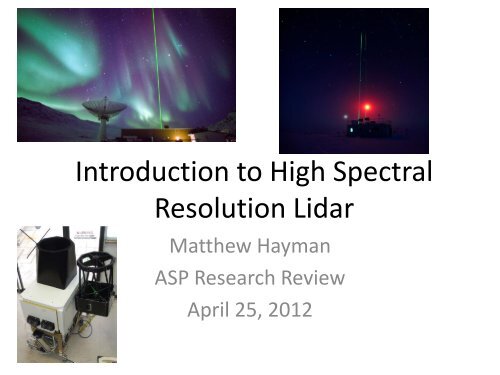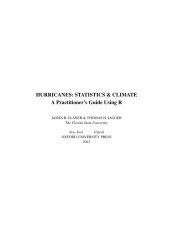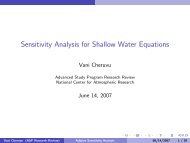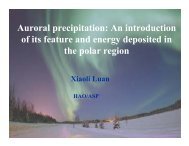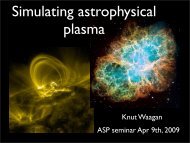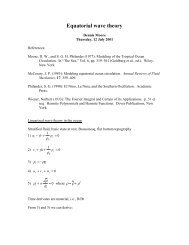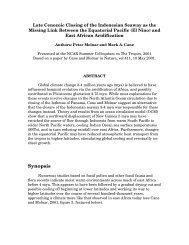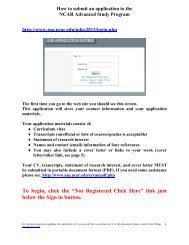Introduction to High Spectral Resolution Lidar
Introduction to High Spectral Resolution Lidar
Introduction to High Spectral Resolution Lidar
You also want an ePaper? Increase the reach of your titles
YUMPU automatically turns print PDFs into web optimized ePapers that Google loves.
<strong>Introduction</strong> <strong>to</strong> <strong>High</strong> <strong>Spectral</strong><br />
<strong>Resolution</strong> <strong>Lidar</strong><br />
Matthew Hayman<br />
ASP Research Review<br />
April 25, 2012
Laser<br />
Telescope/Detec<strong>to</strong>r<br />
Power<br />
Time
Power<br />
Time
Power<br />
Scattering Event<br />
Time
Power<br />
Time
Power<br />
Time
Power<br />
Time
Power<br />
Time/Range<br />
Range =<br />
Time x Light Speed<br />
2
Molecular Density:<br />
Scattering from molecules = Number of Molecules x Scattering from 1 Molecule<br />
Power<br />
Time/Range<br />
Range
Aerosol Detection/Properties:<br />
Total Scattering = Molecular Scattering + Aerosol Scattering<br />
Molecular Density<br />
Power<br />
Time/Range<br />
Range
Aerosol Detection/Properties (Backscattering)<br />
Molecular Density<br />
Aerosol Properties (Extinction)<br />
Molecular Scattering x Extinction<br />
Power<br />
Time/Range<br />
Range
Detected Power = Aerosol Transmission x (BS Mol. + BS Aerosols)<br />
How do we know aerosols<br />
are not also present?<br />
Fewer aerosols or Extinction?<br />
Power<br />
Time/Range
Backscatter Profile
<strong>High</strong> <strong>Spectral</strong> <strong>Resolution</strong> <strong>Lidar</strong><br />
• Pioneered by Ed Eloranta (U.<br />
Wisconsin)<br />
• Designed for aerosol detection<br />
and characterization<br />
Aerosol Motivation<br />
•Major uncertainty in radiative transfer<br />
•Aerosol RT properties<br />
•Condensation Nuclei<br />
•Indica<strong>to</strong>r for Boundary layer height<br />
•Background signal for other instruments
Doppler Shift and Thermal Motion<br />
Spectrum
Doppler Shift and Thermal Motion<br />
Spectrum
Backscatter Spectrum is Doppler<br />
Broadened
1<br />
2<br />
mv 2 =<br />
3<br />
2<br />
k B T<br />
Aerosols<br />
Molecules
<strong>High</strong> <strong>Spectral</strong> <strong>Resolution</strong> <strong>Lidar</strong><br />
Backscattered Signal<br />
Spectrum of Backscattered Signal
<strong>High</strong> <strong>Spectral</strong> <strong>Resolution</strong> <strong>Lidar</strong><br />
Beam Splitter<br />
Iodine Cell<br />
Mol. + Aerosol Channel<br />
Iodine<br />
Transmission
<strong>High</strong> <strong>Spectral</strong> <strong>Resolution</strong> <strong>Lidar</strong><br />
Beam Splitter<br />
Iodine Cell<br />
Molecular Channel<br />
Mol. + Aerosol Channel
Detected Power = Aerosol Transmission x (BS Mol. + BS Aerosols)<br />
How do we know aerosols<br />
are not also present?<br />
Detected Power = Transmission x Backscattering<br />
Fewer aerosols or Extinction?<br />
Power<br />
Time/Range
Detected Power 1 = Aerosol Transmission x (BS Mol. + BS Aerosols)<br />
Detected Power 2 = Aerosol Transmission x BS Mol.<br />
Aerosol Backscatter<br />
Power<br />
Molecular Backscatter Channel<br />
Total Backscatter Channel<br />
Aerosol Extinction<br />
Time/Range
HSRL Profile
HSRL Profile
Polarizing Beam Splitter<br />
1. Transmit Vertical Polarization
1. Transmit Vertical Polarization<br />
2. Scattering Couples Some<br />
Vertical Polarization in<strong>to</strong><br />
Horizontal
P<br />
P<br />
1. Transmit Vertical Polarization<br />
2. Scattering Couples Some<br />
Vertical Polarization in<strong>to</strong><br />
Horizontal<br />
3. Polarizing Beam Splitter<br />
Separates Vertical and<br />
Horizontal Polarizations<br />
Depolarization Ratio<br />
δ = P<br />
P<br />
How much did scattering change the polarization?
Spheres do no change backscattered light’s polarization state<br />
Under MOST conditions, everything else does
Conclusions<br />
•<strong>High</strong> <strong>Spectral</strong> <strong>Resolution</strong> spectrally analyzes backscattered light<br />
•HSRL provides quantitative information on aerosol properties such as<br />
•Aerosol Backscatter<br />
•Aerosol Extinction<br />
•Aerosol Depolarization Ratio<br />
•Characterizes and classifies aerosols<br />
•Sand<br />
•Soot<br />
•Water Phase<br />
•Ice Crystal Orientation<br />
•Temperature and Winds?


